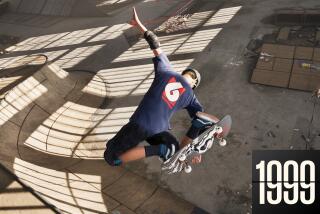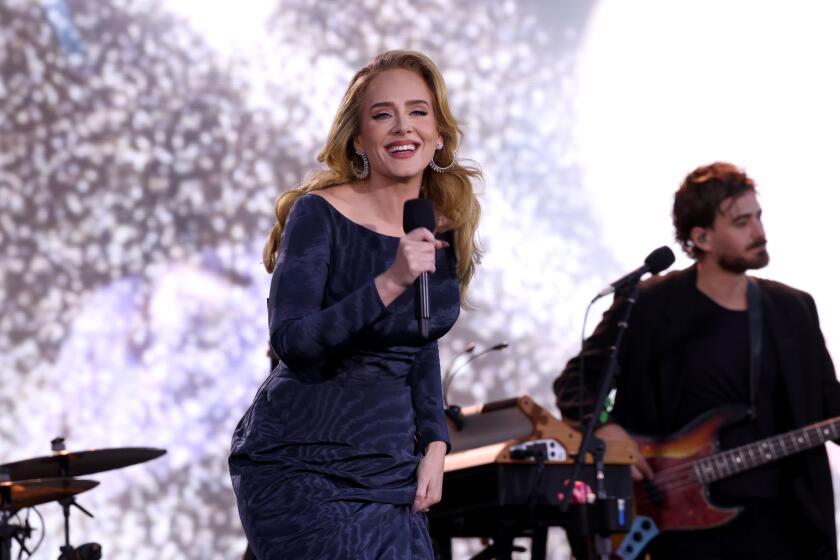Reska Me
For perspective on the boom in ska-influenced music--where it came from, and what might become of it--think of it as the story of the blues, written in miniature.
The blues grew out of the rural South of the 1920s and â30s, where it was invented and nourished by a poor, black underclass. For ska, change the place and time to Trenchtown, the ghetto district of Kingston, Jamaica, in the late â50s and early â60s.
Chapter Two for the blues, spearheaded by such stars as Muddy Waters, John Lee Hooker, Howlinâ Wolf and B.B. King, raised the volume and brought the music to urban centers. Electric blues reached a large audience in the â40s and â50s, but not a mass, mainstream one. Few white folks were paying attention.
In skaâs second phase, the music got louder and changed its venue as a corps of English bands bolstered the original, quick-stepping, scratchy Jamaican rhythms with punk-inspired aggressiveness. The Specials, the English Beat, Madness and the Selecter were huge in their homeland and in Europe. But their 2-Tone sound, named for the racially integrated bandsâ conjoining of musical styles and skin colors, was only popular from 1979-83. And 2-Tone flopped in the United States, the most important market.
Forty years after issuing from its Mississippi Delta cradle, the blues crossed an ocean and landed in the hands of avid young acolytes such as the Rolling Stones, the Animals and the Yardbirds, who were inspired by the musicâs rural originators and urban innovators.
The blues-rock hybrid became commercially gigantic, and the young enthusiasts paused in their pursuit of fame to honor and promote the old masters they had heard on scratchy vinyl.
The ska invasion of â97 finds No Doubt, from Anaheim, selling more records than the â65 Stones ever imagined possible--by SoundScanâs count, fans in the United States have bought 6.8 million copies of âTragic Kingdom.â The Mighty Mighty Bosstones, from Boston, have passed the 500,000 sales mark with their latest album, âLetâs Face It,â and Reel Big Fish, another Orange County band, is on the charts with sales of more than 200,000 units of its CD, âTurn the Radio Off.â
Like the British invaders, these young American inheritors of a roots-music form have added the pop embellishments needed for mass success. And like the Stones, Animals and Yardbirds, they have made a point of praising honored forebears.
Lynval Golding, the founding guitarist of the Specials, the band that launched Englandâs 2-Tone movement, is gratified that the crosscurrents of intergenerational influence and admiration are flowing through skaâs Third Wave.
âWhen bands like No Doubt do an interview, they always say where their influences come from,â Golding said in a recent phone interview from his home in Coventry, England. âPeople reading it will know [about skaâs sources], and if theyâre really into the music, they will do their research and find the stuff from â79. Itâs what we did. We listened to stuff from [ska originals] the Skatalites and Prince Buster from the late â50s.â
The questions now facing ska are:
* Will the new hit bands maintain their success?
* Will their precursors benefit substantially?
* Will ska, like the blues, remain an enduring musical force after faddish or star-driven periods of success run their course?
The second question most concerns the Specials on their current U.S. tour, which stops Saturday at the Galaxy Concert Theatre in Santa Ana. The band is showcasing new material while hoping to land a new record deal, and, ultimately, to capture a chunk of the mass audience now attuned to ska.
The Specials regrouped in 1994 after a 13-year lapse; the current lineup includes four of the six original members, but the band must overcome the absence of two key performers: Keyboard player Jerry Dammers was one of 2-Toneâs most accomplished songwriters, and Terry Hall was the foremost singer in the Specialsâ vocal blend.
âThis tour is quite a make-or-break time for the band,â said Specials original bassist Horace Panter, 43. He and Golding, 44, both regard the bandâs 1996 comeback album, âTodayâs Specials,â as a mistaken attempt to emphasize synthesizers and reggae rhythms--reggae being the slower, more trenchant or, alternately, more laid-back form that evolved out of the light, peppy ska style. âTodayâs Specialsâ (Virgin) has sold 35,000 copies; U.S. fans have much preferred the bandâs original sound, buying 147,000 copies of the 1991 compilation, âThe Singles Collection.â
âWe had this idea we could switch over to being this sort of groovy UB40 kind of band, which didnât work at all,â said Panter, who maintains a wry sense of humor about the Specials and their prospects in the new ska explosion.
âThis time, we got the first and second Specials albums out again and said, âLook guys, this is our meal ticket, this is our raison dâetre, this is what we ought to be doing,â â Panter said. âWe wrote a lot of [new] songs that sound like the Specials and donât have a lot to do with computers.â
With few exceptions, the new, hit-level ska bands offer lightweight, good-time music. The Specials hope to reintroduce the social conscience that was a staple of 2-Tone. The English ska bands had a knack for songs that appealed simultaneously to the feet and the mind.
Said Panter: âIâm sort of concerned that the Third Wave of ska in America is turning into revenge-of-the-nerds music: âHey, we drink lots of beer and play stupid music and have lots of fun and fall over.â The fun element was a given with the Specials. But we were kind of angry young men, and now weâre angry middle-aged men. Injustice is timeless.â
The conventional wisdom about the commercial rise of todayâs ska-pop hybrid is that, by 1996, masses of young music fans had absorbed enough heaviness and angst in the grungy, alienated, alternative-rock â90s. They were ready for the exuberant experience that ska, with its signature rhythmic bounce and bright horn arrangements, was well-positioned to provide.
âI guess kids just decided to smile and dance and go out and enjoy themselves,â said Charlie Dahan, who has supervised a series of recent ska releases on Shanachie Records, a roots-oriented independent label. âIf [a ska song] has a serious message, itâs done in a way thatâs fun and entertaining.â
Ska has good prospects for remaining in popâs mix, even if the newly minted hit-makers turn out to lack staying power on the charts. The ska scene isnât top-heavy; No Doubt and the Bosstones both rose after years of woodshedding in a ska underground that remains well-stocked with veteran bands that enjoy cult followings.
And if the biological principle of hybrid vigor applies to music, ska should thrive. It comes in many strains, with a some traditionalist bands playing the older Jamaican and 2-Tone styles, and even more taking a modernist, mix-and-match approach that combines ska with punk rock, pop, swing and R&B.;
Among the signs of health on skaâs grass-roots are solid independent-label sales.
* Shanachieâs Dahan said that most of the labelâs ska releases have sold more than 10,000 copies, a benchmark of indie-label success; a mid-â90s release by the Skatalites has sales approaching 30,000, showing continued audience interest in the work of skaâs founding fathers.
* Robert âBucketâ Hingley, one of the key figures in transplanting ska from England to the U.S., says that his New York City-based label, Moon Ska, is peaking after 14 years devoted to releases by Third Wave ska bands. Hingley, a U.K. native, has led his band, the Toasters, since 1981; along with the L.A. bands Fishbone and the Untouchables, the Toasters are credited with fostering ska music in the United States after the attempted British 2-Tone invasion fizzled.
Moon Skaâs roster has grown to more than 30 bands, and Hingley says that sales of albums by such top acts as the Toasters, Letâs Go Bowling, the Scofflaws and Mephiskapheles have approached or passed the 40,000 mark.
* The leading independent punk label, L.A.-based Epitaph Records, has spun off a new subsidiary, Hellcat Records, devoted largely to Third Wave ska music. Cris âThe Wixâ Qualiana, who is running Hellcatâs day-to-day affairs, sees no reason for concern that the emergence of new ska labels and the expansion of old ones might lead to lowered standards of quality--something that quickly robbed pop-punk of its freshness after its commercial explosion in 1994.
âItâs not a problem,â she said. âWe came into this with the idea of [signing] one or two bands, and now we have six or seven. Thereâs definitely enough [good] music.â
Naturally, some old-line supporters of ska are nervous about what mainstream success could do to the music. Shanachieâs Dahan says thatâs borne out by the beating No Doubt takes on ska bulletin boards on the Internet, as purists and cultists feel threatened by mass acceptance and stylistic change.
âMy main concern nowadays is to keep the underground as healthy as the overground, and keep the industry on their toes, so they donât water down the music,â said Tazy Phyllipz, a leading ska authority who has been hosting âThe Ska Paradeâ weekly radio show on UC Irvine station KUCI-FM (88.9) since 1990.
Moon Skaâs Hingley doesnât have any qualms that success might spoil ska music; he says it is too deeply rooted, too adaptive and resilient to lose its musical essence and its subcultural appeal.
âI donât think commercialization of the genre is as much a danger as purists might think,â Hingley said. âIf it hasnât been destroyed and eaten up by the big, bad music business previously, I donât see why it should now. The fact there is 40 years behind it will protect it from superficial trimming.â
BE THERE
The Specials, play Saturday at the Galaxy Concert Theatre, 3503 S. Harbor Blvd., Santa Ana. With Cherry Poppinâ Daddies, Tijuana No! and the Extras. 8 p.m. $15-$17. (714) 957-0600.
More to Read
The biggest entertainment stories
Get our big stories about Hollywood, film, television, music, arts, culture and more right in your inbox as soon as they publish.
You may occasionally receive promotional content from the Los Angeles Times.











